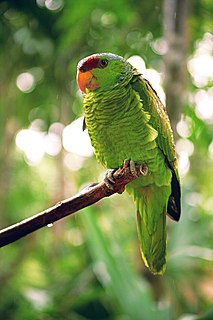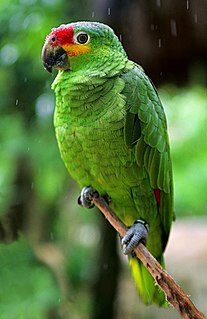 W
WAmazon parrot is the common name for a parrot of the genus Amazona. They are medium-sized parrots native to the New World ranging from South America to Mexico and the Caribbean.
 W
WAmazon parrot is the common name for a parrot of the genus Amazona. They are medium-sized parrots native to the New World ranging from South America to Mexico and the Caribbean.
 W
WThe black-billed amazon is a parrot endemic to Jamaica. Sometimes called the black-billed parrot, this amazon parrot is mostly green with small patches of red on the wing and sometimes flecked on the head. Its bill makes it easy to separate from most other amazons, including the yellow-billed amazon, which also lives in Jamaica. It is the smallest Amazona parrot at 25 cm (10 in).
 W
WThe blue-cheeked amazon, also known as blue-cheeked parrot or Dufresne's amazon, is a parrot found in northeast South America in eastern Venezuela, the Guianas and possibly far northern Brazil. It lives in forest and savanna woodlands up to 1,700 m (5,600 ft).
 W
WThe festive amazon, also known as the festive parrot, is a species of parrot in the family Psittacidae. It is found in Brazil, Colombia, Ecuador, Bolivia, Guyana, Peru, and Venezuela. It is associated with forest and woodland growing near major rivers. Locally it is also found in coastal mangroves. There are two subspecies; A. f. festiva and A. f. bodini.
 W
WThe Guadeloupe amazon or Guadeloupe parrot is a hypothetical extinct species of parrot that is thought to have been endemic to the Lesser Antillean island region of Guadeloupe. Mentioned and described by 17th and 18th century writers, it received a scientific name in 1789. It was moved to the genus Amazona in 1905, and is thought to have been related to, or possibly the same as, the extant imperial amazon. A tibiotarsus and an ulna bone from the island of Marie-Galante may belong to the Guadeloupe amazon. In 1905, a species of extinct violet macaw was also claimed to have lived on Guadeloupe, but in 2015 it was suggested to have been based on a description of the Guadeloupe amazon.
 W
WThe imperial amazon or Dominican amazon, also known as the sisserou, is a parrot found only on the Caribbean island of Dominica. It has been designated as the national bird of Dominica.
 W
WThe lilac-crowned amazon is a parrot endemic to the Pacific slopes of Mexico. Also known as Finsch's amazon, it is characterized by green plumage, a maroon forehead, and violet-blue crown and neck.
 W
WThe lilacine amazon is an amazon parrot native to Ecuador in South America. The lilacine amazon is generally smaller than its related species, with a black beak and more subdued coloring. Lilacine amazons are said to make favorable companion parrots because of their gentle, affectionate nature and agreeable temperament. According to the IOC World Bird List, it is still considered to be a subspecies of the red-lored amazon as Amazona autumnalis lilacina.
 W
WThe northern mealy amazon or northern mealy parrot is among the largest parrots in the genus Amazona, the amazon parrots. It is a mainly green parrot with a total length of 38–41 cm (15–16 in). It is endemic to tropical Central America. This species and the southern mealy amazon were previously considered conspecific. Some taxonomic authorities (including the American Ornithological Society, continue to lump them together.
 W
WThe orange-winged amazon, also known locally as orange-winged parrot and loro guaro, is a large amazon parrot. It is a resident breeding bird in tropical South America, from Colombia, Trinidad and Tobago south to Peru, Bolivia and central Brazil. Its habitat is forest and semi-open country. Although common, it is persecuted as an agricultural pest and by capture for the pet trade. It is also hunted as a food source. Introduced breeding populations have been reported in Puerto Rico.
 W
WThe Panama amazon, also known as the Panama yellow-headed amazon, is a subspecies of the yellow-crowned amazon, and is endemic to Panama and northwest Colombia. In aviculture, it is sometimes listed as a separate species, and this is potentially correct; at least as a phylogenetic species.
 W
WThe Puerto Rican amazon, also known as the Puerto Rican parrot or iguaca, is the only extant parrot endemic to the archipelago of Puerto Rico, and belongs to the Neotropical genus Amazona. Measuring 28–30 cm (11.0–11.8 in), the bird is a predominantly green parrot with a red forehead and white rings around the eyes. Two subspecies have been described, although there are doubts regarding the distinctiveness of the form gracilipes from Culebra Island, extinct since 1912. Its closest relatives are believed to be the Cuban amazon and the Hispaniolan amazon.
 W
WThe red-browed amazon is a species of parrot in the family Psittacidae. It is endemic to Atlantic Forest in eastern Brazil. It has been considered a subspecies of the blue-cheeked amazon, but today all major authorities consider them separate species. It is threatened both by habitat loss and by being captured for the trade in wild parrots.
 W
WThe red-crowned amazon, also known as the red-crowned parrot, green-cheeked amazon or Mexican red-headed parrot, is a highly social, endangered amazon parrot native to northeastern Mexico and the southwestern United States. The current native wild population of between 1,000 and 2,000 is decreasing. The main threats to the native bird's survival are the illegal export of trapped birds from Mexico to the United States for the pet trade and the destruction of their natural habitat, the lowland forests of northeastern Mexico.
 W
WThe red-lored amazon or red-lored parrot is a species of amazon parrot, native to tropical regions of the Americas, from eastern Mexico south to Ecuador where it occurs in humid evergreen to semi-deciduous forests up to 1,100 m altitude. It is absent from the Pacific side of Central America north of Costa Rica. Not originally known from El Salvador, a pair - perhaps escaped from captivity - nested successfully in 1995 and 1996 in the outskirts of San Salvador and the species might expand its range permanently into that country in the future. This species has also established feral populations in several California cities.
 W
WThe red-necked amazon, also known as the red-necked parrot, Dominican blue-faced amazon, lesser Dominican amazon, and Jaco parrot, is an amazon parrot endemic to Dominica.
 W
WThe red-tailed amazon, also known as the red-tailed parrot, is a species of parrot in the family Psittacidae. It is endemic to coastal regions in the south-east Brazilian states of São Paulo and Paraná. The bird has been threatened by habitat loss and capture for the wild bird trade, and is a symbol of the efforts to conserve one of the Earth's most biologically diverse ecosystems. Consequently, it is considered Near Threatened by BirdLife International and the IUCN. In 1991–92, the population had fallen below 2000 individuals. Following on-going conservation efforts, a count and estimate from 2015 suggests a population of 9,000–10,000, indicating that this species is recovering from earlier persecution. A recent study shows that the population of this species is stable at Paraná state, Southern Brazil, revealing population trend fluctuation during the last 12 years.
 W
WThe Saint Lucia amazon also known as the Saint Lucia parrot is a species of parrot in the family Psittacidae. It is endemic to Saint Lucia and is the country's national bird.
 W
WThe Saint Vincent amazon also known as Saint Vincent parrot, is a large, approximately 40 cm long, multi-colored amazon parrot with a yellowish white, blue and green head, greenish-bronze upperparts plumage, and violet blue-green wings.
 W
WThe scaly-naped amazon, also known as the scaly-naped parrot, mercenary amazon, Tschudi's amazon, mountain parrot, or gray-naped amazon is a species of parrot in the family Psittacidae. It is found along the Andes in the northern part of South America. Its natural habitats are subtropical or tropical moist lowland forest and subtropical or tropical moist montane forest.
 W
WThe southern mealy amazon or southern mealy parrot is among the largest parrots in the genus Amazona, the amazon parrots. It is a mainly green parrot with a total length of 38–41 cm (15–16 in). It is endemic to tropical Central and South America. This species and the northern mealy amazon were previously considered conspecific. Some taxonomic authorities, continue to lump them together.
 W
WThe turquoise-fronted amazon, also called the turquoise-fronted parrot, the blue-fronted amazon and the blue-fronted parrot, is a South American species of amazon parrot and one of the most common amazon parrots kept in captivity as a pet or companion parrot. Its common name is derived from the distinctive turquoise marking on its head just above its beak.
 W
WThe vinaceous-breasted amazon is a species of parrot in the family Psittacidae. It is found in Argentina, Brazil, and Paraguay.
 W
WThe white-fronted amazon also known as the white-fronted parrot, or by the adopted slang term spectacled amazon parrot, is a Central American species of parrot. Not to be confused with the red-spectacled amazon. They can imitate a range from 30 to 40 different sounds. Like other large parrots, the white-fronted parrot has a long potential life span, usually around 40 years.
 W
WThe yellow-billed amazon, also called the Jamaican amazon, is a species of parrot in the family Psittacidae. It is a predominantly green parrot with a short tail and pink throat and neck. It is endemic to Jamaica, where its natural habitats are subtropical or tropical moist lowland forests, subtropical or tropical mangrove forests, subtropical or tropical moist montane forests, plantations, and rural gardens. It is threatened by habitat loss and illegal trapping of wild birds for the pet trade.
 W
WThe yellow-crowned amazon or yellow-crowned parrot is a species of parrot native to tropical South America, Panama and Trinidad and Tobago. The taxonomy is highly complex and the yellow-headed and yellow-naped amazon are sometimes considered subspecies of the yellow-crowned amazon. Except in the taxonomic section, the following deals only with the nominate group .They are found in the Amazon basin.
 W
WThe yellow-headed amazon, also known as the yellow-headed parrot and double yellow-headed amazon, is an endangered amazon parrot of Mexico and northern Central America. Measuring 38–43 centimetres (15–17 in) in length, it is a stocky short-tailed green parrot with a yellow head. It prefers to live in mangrove forests or forests near rivers or other bodies of water. It is sometimes considered a subspecies of the yellow-crowned amazon. It is a popular pet and an excellent talker. Poaching for the international pet trade has driven the species to near-extinction in the wild; around half of all wild-caught birds are thought to die in the process. The yellow-headed amazon is CITES I listed, and there are legal restrictions on its trade and ownership, including a certification system.
 W
WThe yellow-naped amazon or yellow-naped parrot is an endangered amazon parrot sometimes considered to be a subspecies of the yellow-crowned amazon.
 W
WThe yellow-shouldered amazon also known as yellow-shouldered parrot is a parrot of the genus Amazona that is found in the arid areas of northern Venezuela, the Venezuelan islands of Margarita and La Blanquilla, and the island of Bonaire. It has been extirpated from Aruba and possibly also Curaçao.
 W
WThe Yucatan amazon, also known as the yellow-lored amazon, Yucatan parrot or yellow-lored parrot is a species of amazon parrot in the family Psittacidae. It is found in Belize, Honduras, and Mexico. Its natural habitats are subtropical or tropical dry forests, coastal mangroves and heavily degraded former forest; an example location of occurrence is in the Petenes mangroves ecoregion of the Yucatan.